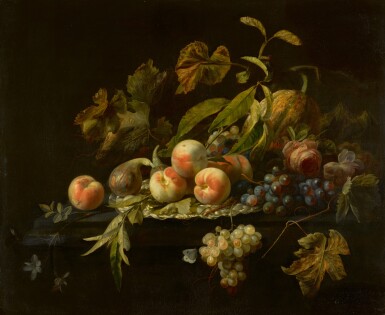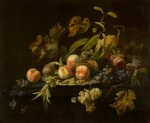Old Masters including Portrait Miniatures from the Pohl-Ströher Collection
Old Masters including Portrait Miniatures from the Pohl-Ströher Collection

Property from a Swiss Private Collection
HERMAN PIETERSZ. VERELST | Still life of peaches, a fig, a watermelon, bunches of grapes and a rose arranged on and around a silver dish on a ledge
拍品已结束竞投
May 7, 02:36 PM GMT
估价
15,000 - 20,000 GBP
拍品信息
描述
Property from a Swiss Private Collection
HERMAN PIETERSZ. VERELST
The Hague(?) 1641/2 - 1702 London
STILL LIFE OF PEACHES, A FIG, A WATERMELON, BUNCHES OF GRAPES AND A ROSE ARRANGED ON AND AROUND A SILVER DISH ON A LEDGE
signed and dated lower right: H. Verelst. F. / 1687
oil on canvas
unframed: 75.5 x 90 cm.; 28¾ x 35½ in.
framed: 98 x 110 cm.; 38 5/8 x 43 3/8 in.
Please note, Condition 11 of the Conditions of Business for Buyers (Online Only) is not applicable to this lot.
To view shipping calculator, please click here
Anonymous sale, London, Christie's, 17 November 1950, lot 162, for 45 guineas to Nicholls.
A. van der Willigen and F.G. Meijer, A Dictionary of Dutch and Flemish Still-life painters working in oils 1525 - 1725, Leiden 2003, p. 204.
This is a very rare still-life by Herman Verelst, who was the son of the genre painter Pieter Verelst (1618-88) and elder brother of the well-known flower painter Simon Verelst (1644-1721). Together with his brother he joined the Painters' Guild in The Hague in 1663, and both shortly after settled in nearby Voorburg. While Simon left for England in 1668/9 to pursue a successful career as a still-life painter, Herman stayed in Holland before travelling to Italy in 1680 and then to Vienna. In 1683 he fled Vienna at the approach of the Turkish armies and taking his family, rejoined his brother in London. Here, like his brother, he worked as a still-life painter, and seems to have enjoyed steady patronage as a portraitist. Their close relationship is witnessed by a near identical version of this composition painted by Simon and today in a private collection, which suggests both were painted in London.1 Although fruit still lifes such as this are now extremely rare in Herman's œuvre, as Meijer notes, old records of his work in this vein refer mainly to fruit pieces, sometimes specifically mentioning silver objects such as the dish found in the present canvas. Herman died in London in 1702 and his posthumous sale was held on the 31 December of that year.2
1 Information kindly provided by Dr. Fred G. Meijer.
2 E.K. Waterhouse, The Dictionary of 16th and 17th century British Painters, Woodbridge 1988, p. 283.
